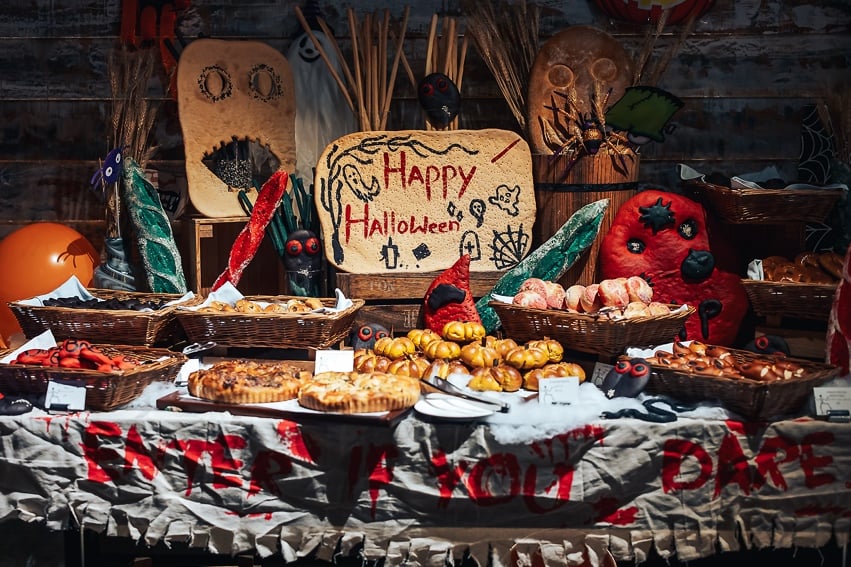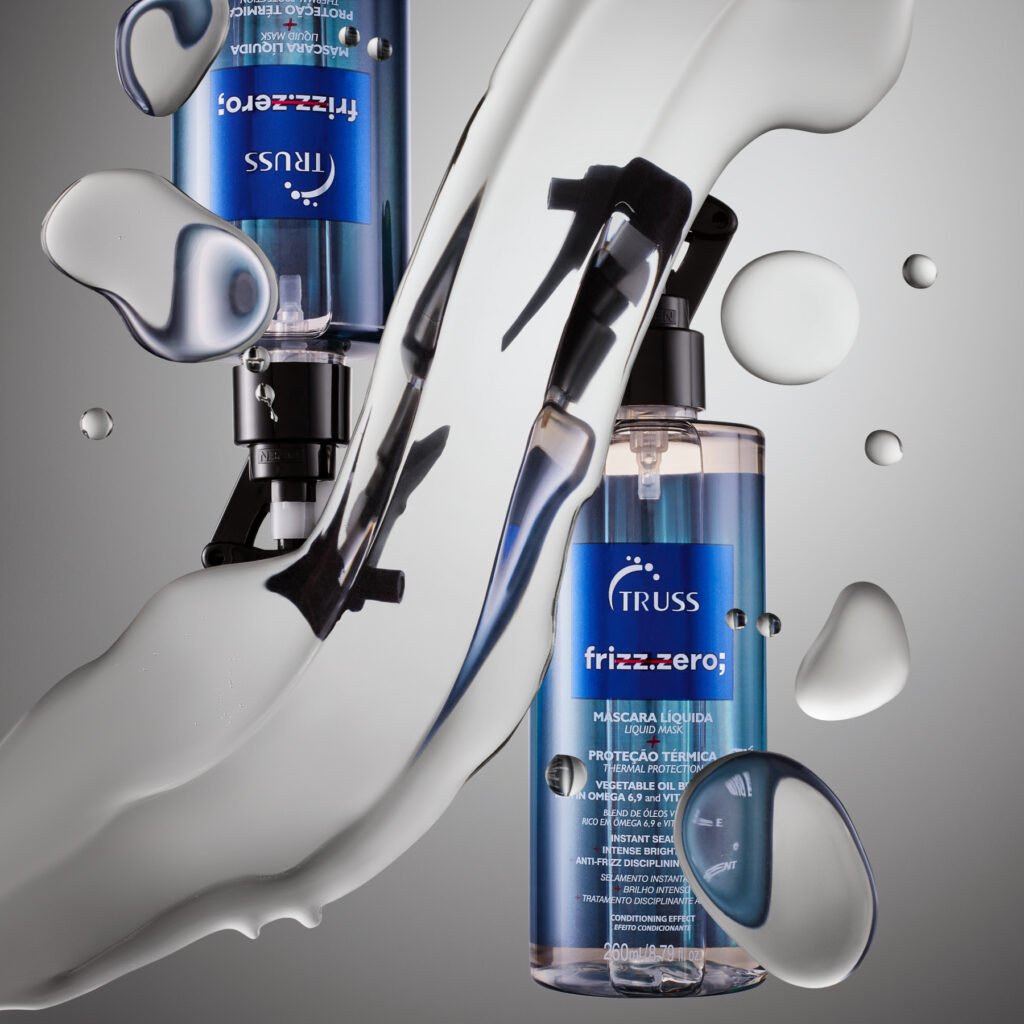The Wildlife Photographer of the Year competition is back, celebrating the most extraordinary life with which humans share this planet while spotlighting the many threats the natural world faces.
From a record-breaking number of entries to its 61st competition, organisers have unveiled a first look at 15 inspiring and powerful images of our natural world.
The finalists, taken by some of the finest professional and emerging young wildlife photographers today, were chosen from 60,636 entries.
Take a look at this year’s Wildlife Photographer of the Year images as shortlisted by the UK’s Natural History Museum with a sneak preview including bellowing stags, scratching flamingos, an elephant amidst a sea of rubbish, a defiant lion, a shy sloth and ethereal jellyfish.
Rutting Call by Jamie Smart
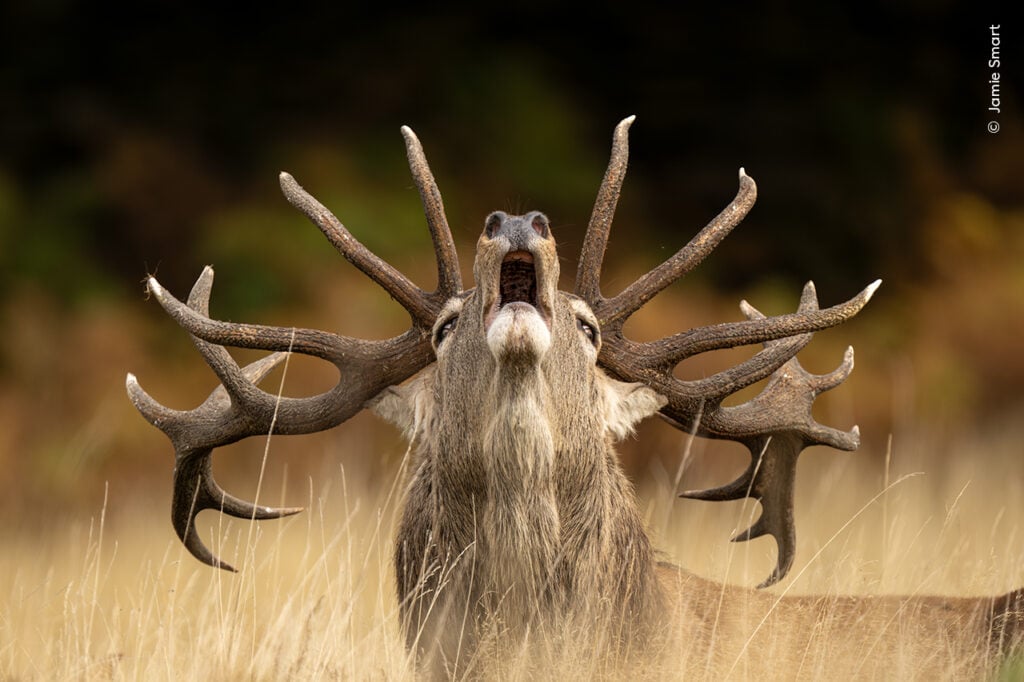
A large red deer stag with big antlers tips its head back as it bellows with an open mouth.
Every year, the red deer stags in Bradgate Park, UK, gather to compete for the females. As Jamie walked through the long grass, she had to stretch herself up tall to get just the right position to capture this stag as he raised his head to bellow.
Each deer sheds and regrows its antlers every year. The number of points on this male show that it is an experienced male who’s likely competed many times before.
The stag’s antlers have regrown since their annual shedding in spring. The ‘velvet’ – the soft skin that covered them during their growth – has now rubbed off, exposing the bone beneath. Each new set grows larger and more complex as the stag matures, with more intricate points called tines crowning the heads of older males.
Ice Edge Journey by Bertie Gregory
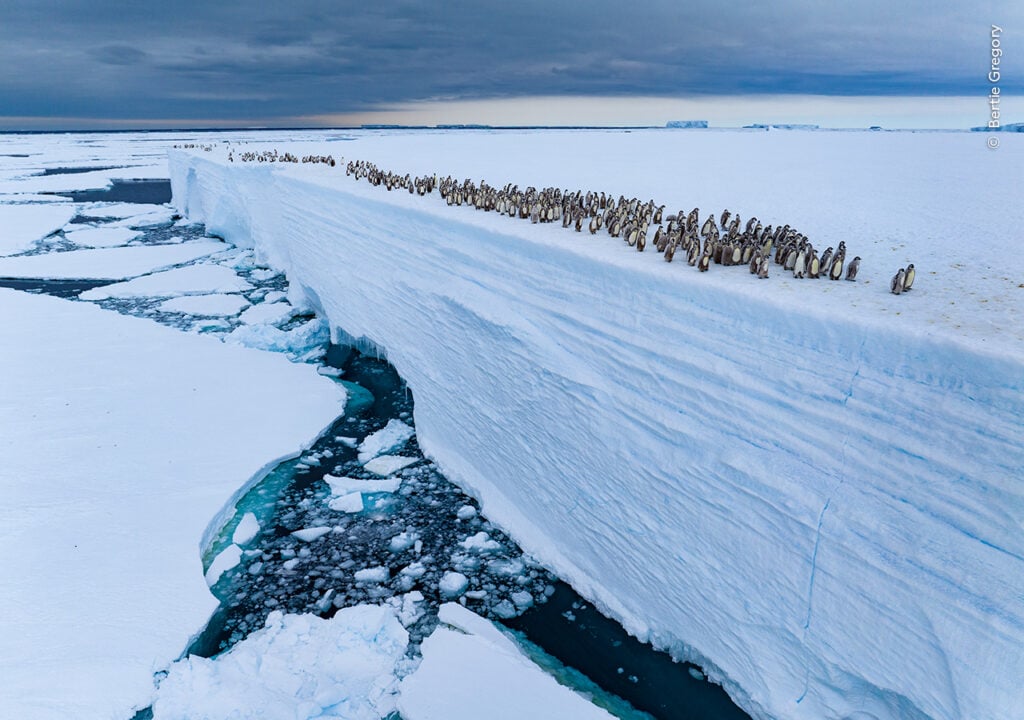
A group of a hundred penguins follow the edge of a huge ice cliff. Below the penguins, the water is covered in broken up ice.
Bertie caught the moment when a group of fledgling emperor penguin chicks were about to take a 15-metre plunge from an ice cliff down into the freezing Antarctic Ocean.
Every year, penguin chicks have to make the perilous solo journey from the nesting grounds to the water’s edge. As the Antarctic warms because of the climate crisis, this journey is becoming more and more perilous.
Left to fend for themselves, emperor penguin chicks must find a way to make their first dip into the icy ocean to find food. Scientists believe the continued decline of sea ice in Antarctica may force more penguins to breed on ice shelves, making this behaviour increasingly common in the future.
Toxic Tip by Lakshitha Karunarathna
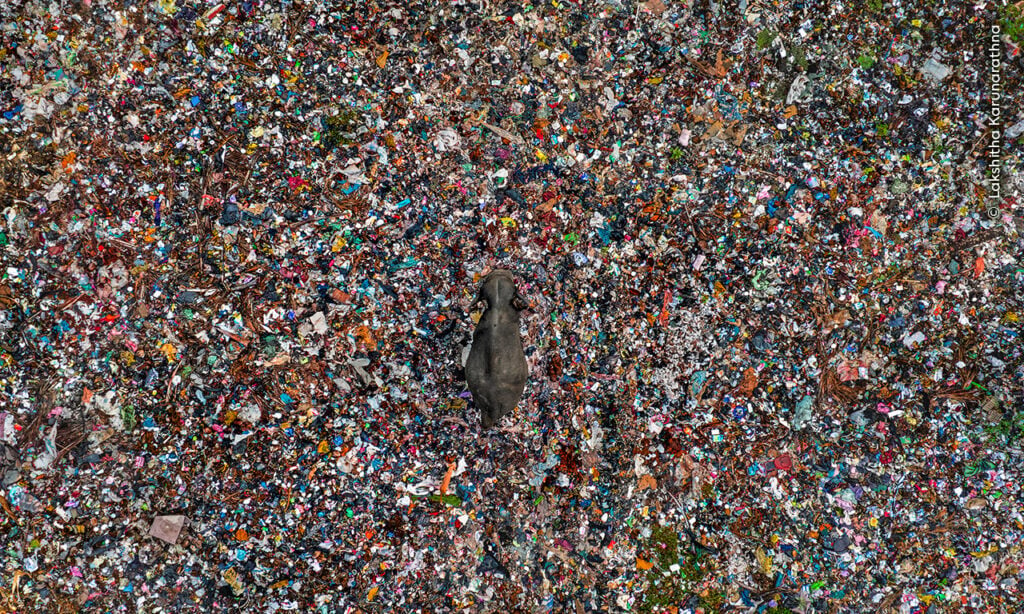
A lone elephant walks through a multicoloured patchword of rubbish, which fills the entire view as it navigates its way through a waste disposal site in Sri Lanka.
Lakshitha has been recording the conflict that arises between people and the roughly 7,500 elephants on the island. Unfortunately, this regularly includes those that forage for food among Sri Lanka’s open rubbish dumps.
Around 20 elephants died over an eight-year period at this single site in Ampara after consuming indigestible food wrappers and other plastic waste. Alongside global efforts to reduce plastic use, conservationists stress the urgent need to secure landfills and prevent wildlife from accessing harmful materials.
Pink Pose by Leana Kuster
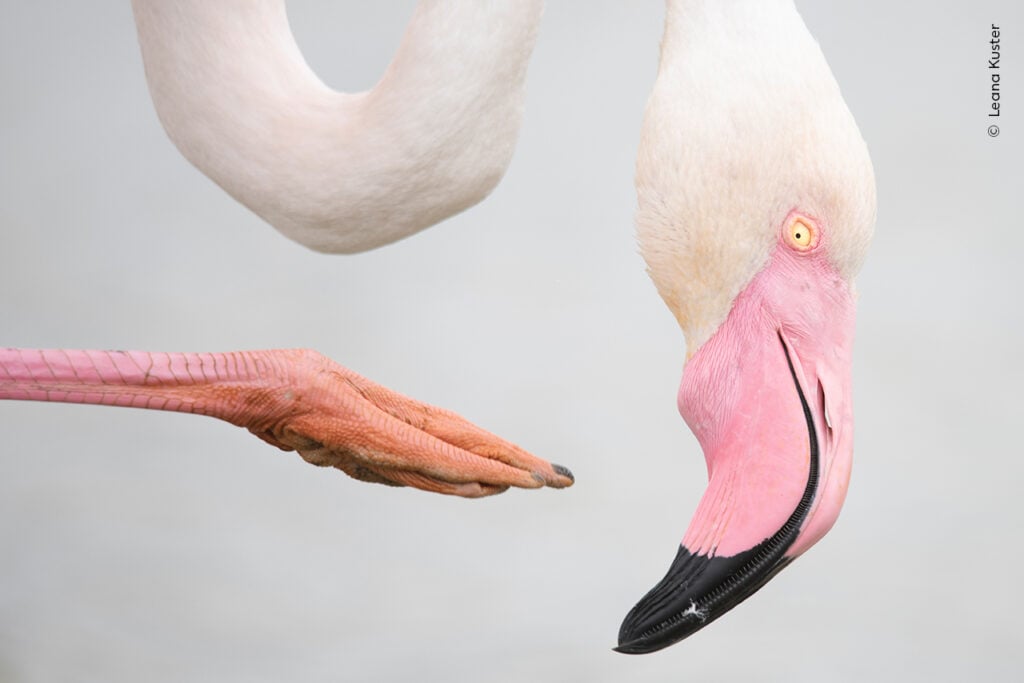
A close up image of a flamingo raising its foot to its head just as it is about to give itself a good scratch.
The extensive wetlands of Camargue in southern France are a haven for all kinds of waterbirds, including one of Europe’s most recognisable avian residents: the greater flamingo.
As Leana watched these elongated birds move gracefully through the shallows, she couldn’t miss the moment when one raised its long legs to sate an itch on its head.
Flamingos use their tongues to force water through their specially adapted bills, which are lined with many rows of fine, comb-like plates. These help trap a species of brine shrimp called Artemia salina that gives the birds their famous pink hue.
Deadly Lesson by Marina Cano
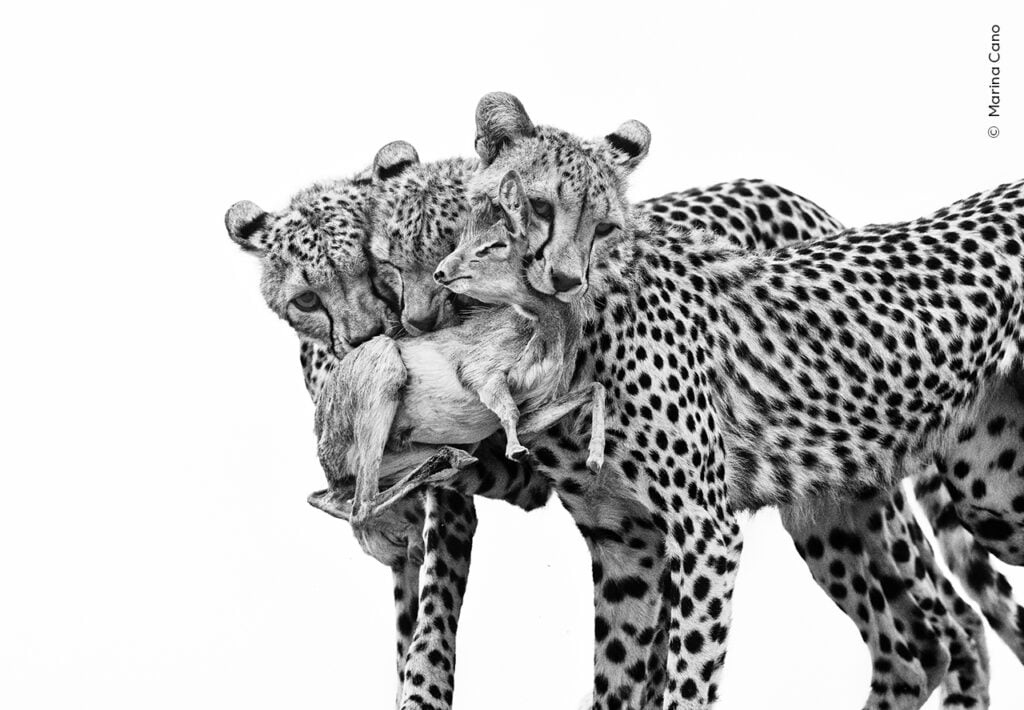
A black and white image of three cheetahs all stood close to each other. All three of them are biting a dik-dik antelope, which is held aloft in their mouths.
This image shows the brutal nature of how the world’s fastest land predator learns its survival skills.
Three young cheetah cubs had been practising how to hunt in Samburu National Reserve, Kenya, when one of them caught an unfortunate dik-dik antelope. Not long after Marina took this image, the little animal was quickly dispatched by the siblings.
Fragile River of Life by Isaac Szabo
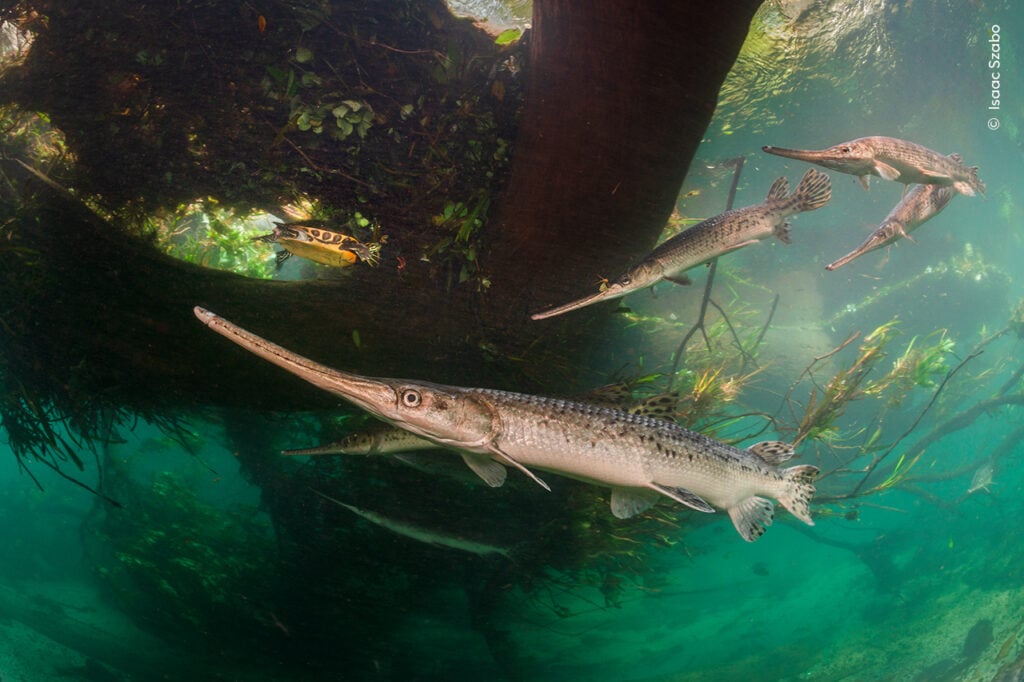
An underwater scene in which a longnosed gar fish swims under a log. In the background three other four other gars follow the first.
By wrapping his feet around a drowned tree to stay steady, Isaac documented a scene that has been going on almost unchanged in Florida’s rivers for some 100 million years.
Longnose gar and their relatives have been around since the time of the dinosaurs, making this moment in which a female spawns in the crystal-clear waters all that more special.
Wake-up Call by Gabriella Comi
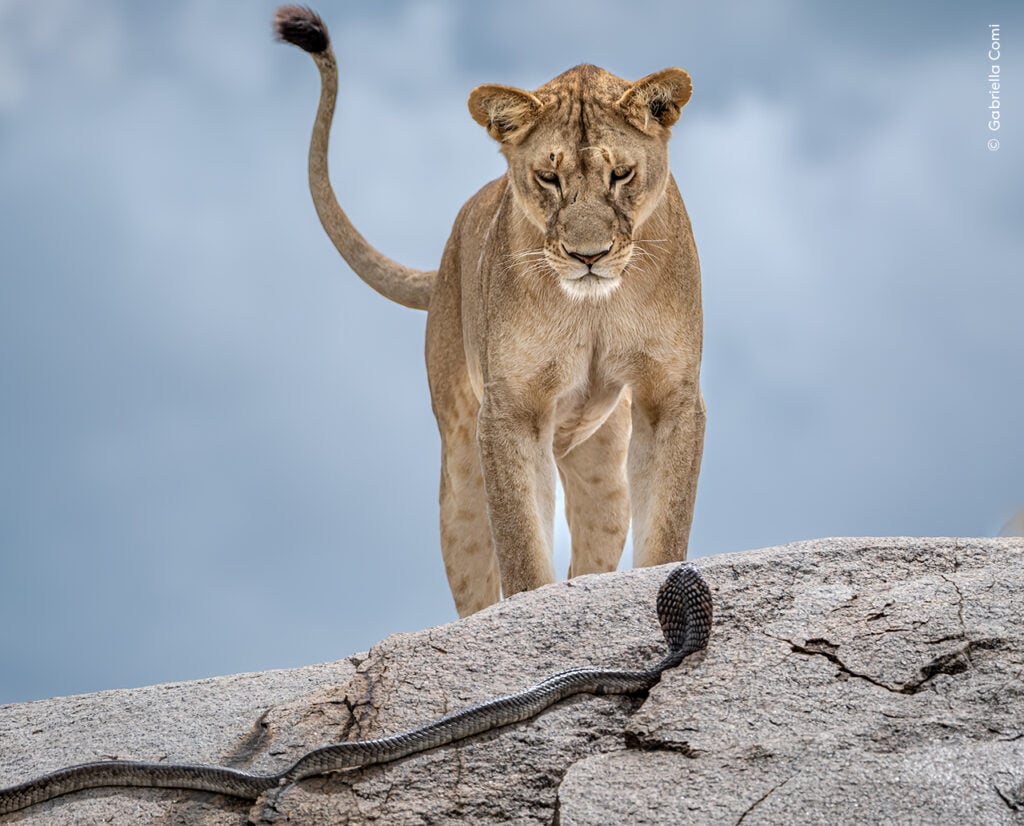
A female lion stands on the top of a rounded rock, looking down at a cobra snake that staring directly back at the big cat.
Two of Africa’s most impressive predators come face to face in the Serengeti National Park, Tanzania.
The scene unfolded in front of Gabriella, as a pair of sleeping lions were awoken by a cobra slithering towards them over the rocks. Within seconds, one of the cats was facing down the snake, giving Gabriella the perfect shot.
Jelly Smack Summer by Ralph Pace
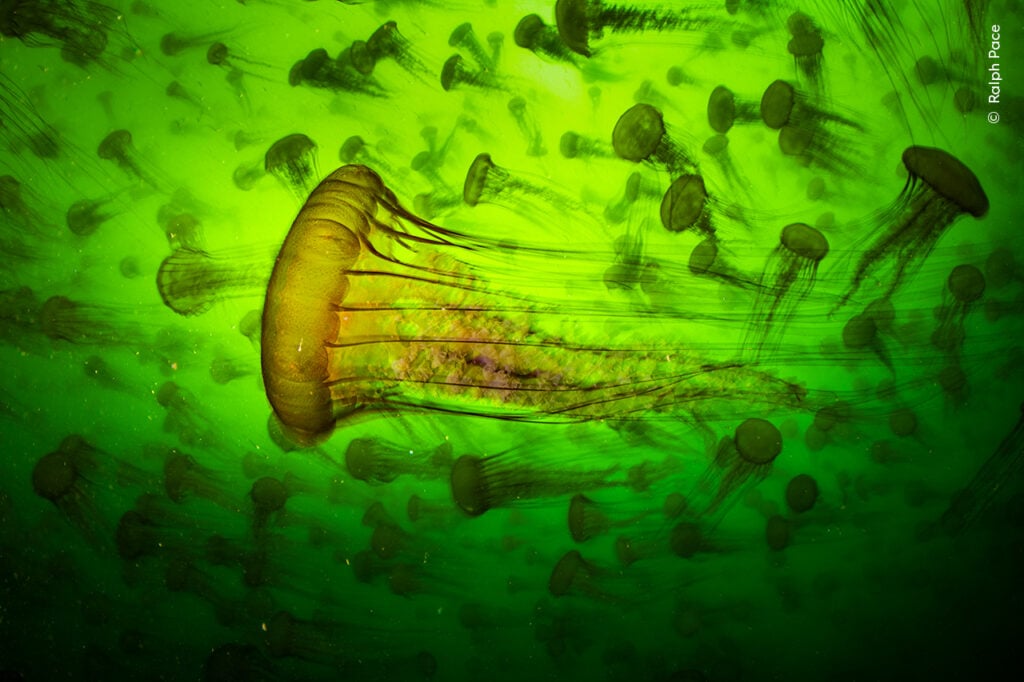
A beautiful jellyfish drifts through the middle of the frame, while in the background countless more can be seen out of focus. Everything is bathed in a glowing green light.
Swimming through a mass, or ‘smack’, of jellyfish won’t appeal to many people. But for Ralph it provided the perfect setting for an other-worldly image of swarming sea nettles.
Smearing every bit of exposed skin with petroleum jelly, Ralph was able to float among the animals protected from their trailing stinging tentacles.
Nature Reclaims Its Space by Sitaram Raul
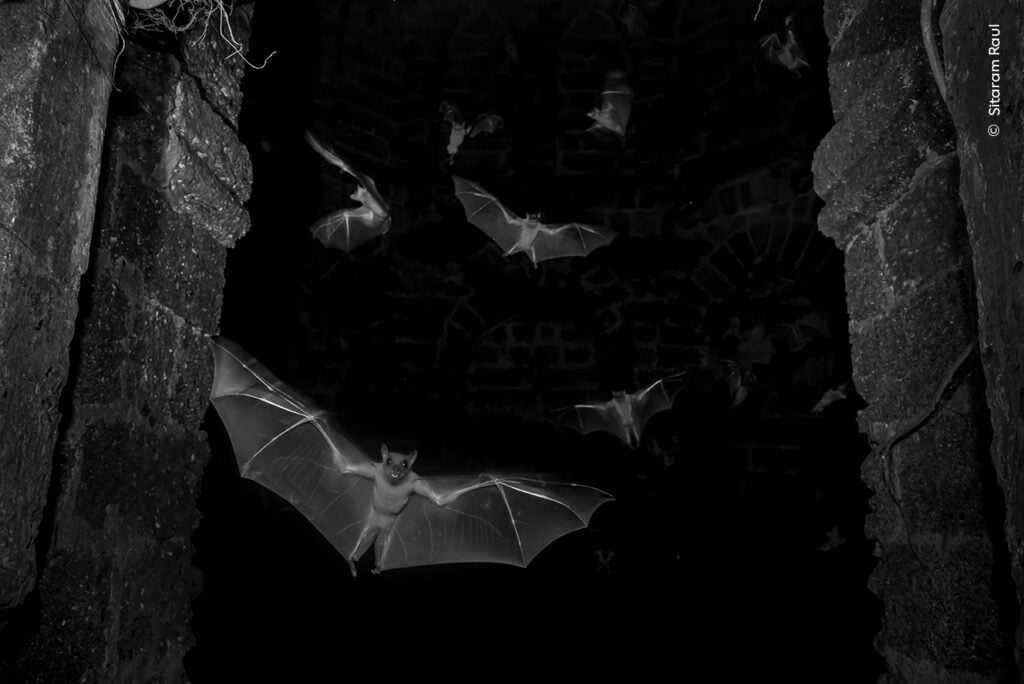
A group of fruit bats flying towards the camera with their wings wide open, between two large stone built walls framing the bats on either side. The image is taken at night in black and white giving the image a slightly menacing feel.
Sitting in total darkness as he could feel the bats flying all around him, Sitaram pointed his camera and focused it where he hoped the animals would be.
A flash of light reveals the chaotic flutter of fruit bats as they leave their roost in the ruins of a historical monument in Banda, India. No matter how big our urban structures, nature will eventually reclaim them.
Clouds of Gold by Jassen Todorov
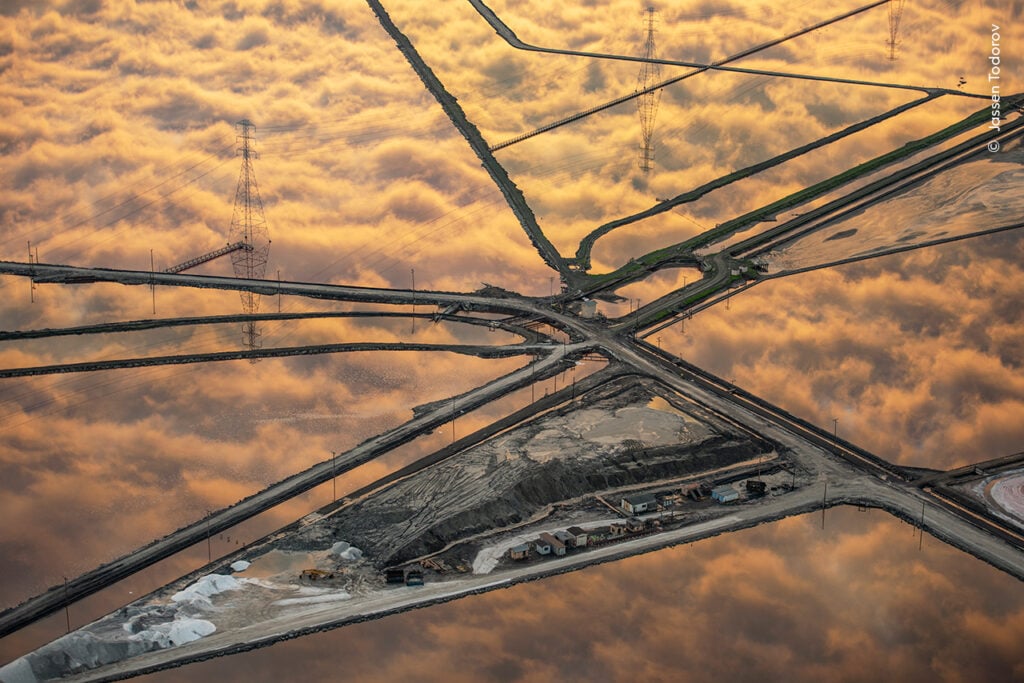
A view of still pools perfectly reflecting the golden, swirling clouds above. The pools are criss-crossed by numerous roads and banks.
The still waters of San Francisco’s salt ponds form a crystal-clear mirror, reflecting the rolling clouds and golden light above.
Salt has been collected in this region since the 1800s. In the last two decades, conservation projects have returned this intertidal environment to the salt marshes that were originally there.
Essence of Kamchatka by Kesshav Vikram
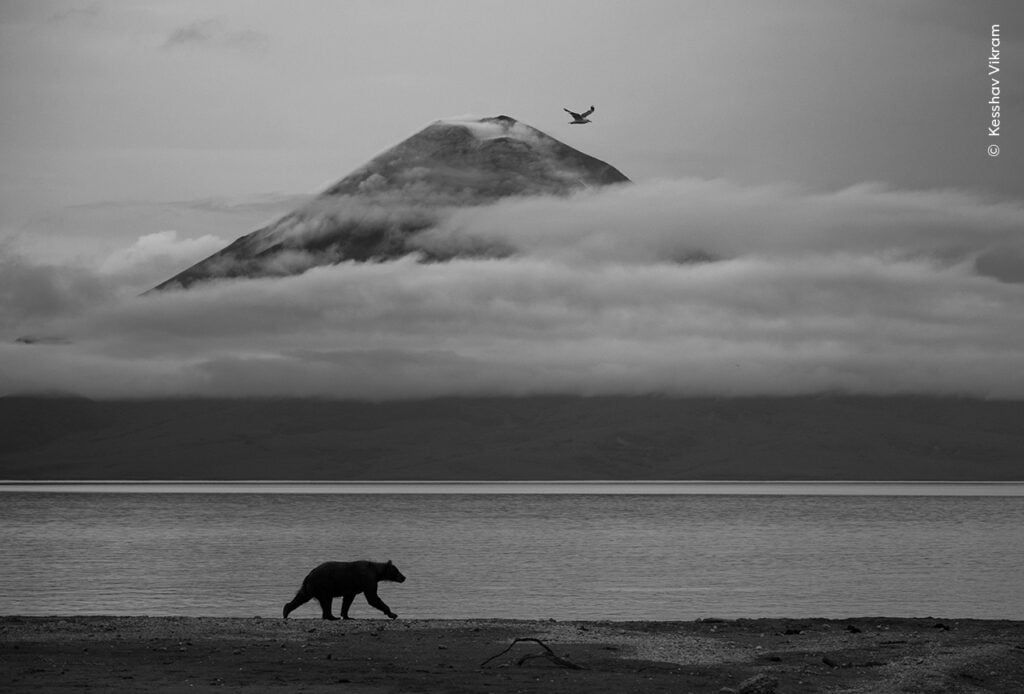
A black and white image of a single bear walking along a beach in the foreground. In the background, a triangular volcano rises from the clouds as bird flies past.
As the Iliinsky volcano rises in the background through a curtain of cloud on the Kamchatka Peninsula, a solitary brown bear strolls along the shoreline.
Despite striking a lonely figure on the beach, the bear was on its way to join many other members of its species. Every year the caldera lake is the spawning ground for stockeye salmon on which the bears gather annually to feast.
No Place Like Home by Emmanuel Tardy
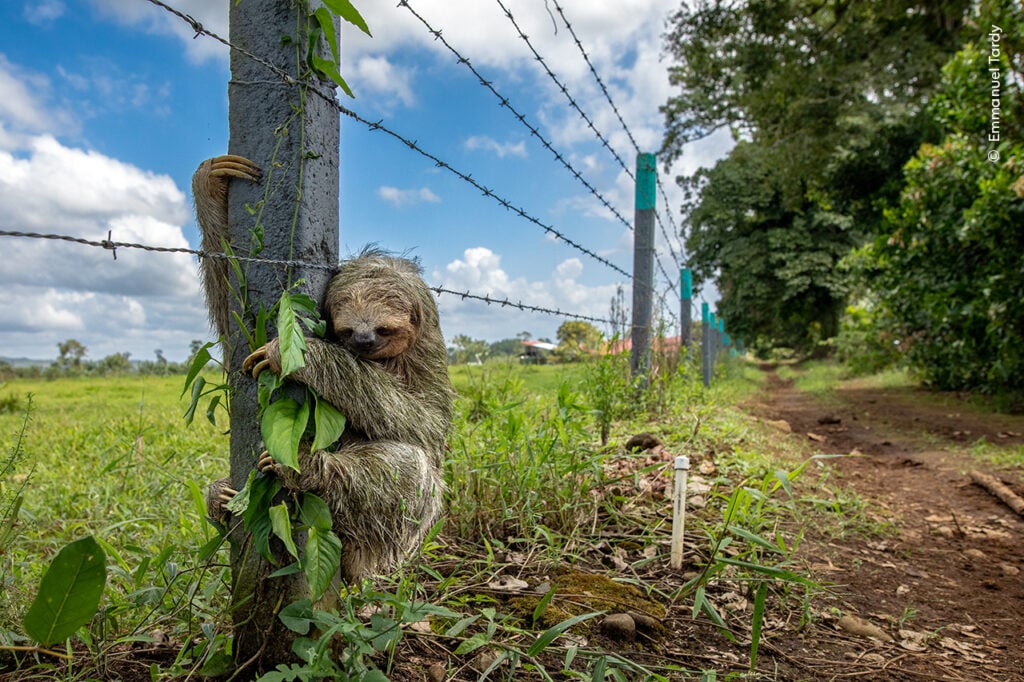
A small sloth clings to the post of barbed wire fence, with its head tucked in and eyes closed as if it is trying to hide.
Emmanuel waited for the crowds to disperse before taking this picture of a confused brown-throated three-toed sloth. It had just crossed a road and made a beeline for the first thing that resembled a tree.
Unfortunately, as the sloth’s forest homes become more fragmented, more of them have to descend from the safety of the trees as they move around. The Costa Rican government is now working to help establish aerial bridges to protect them.
A Tale of Two Coyotes by Parham Pourahmad
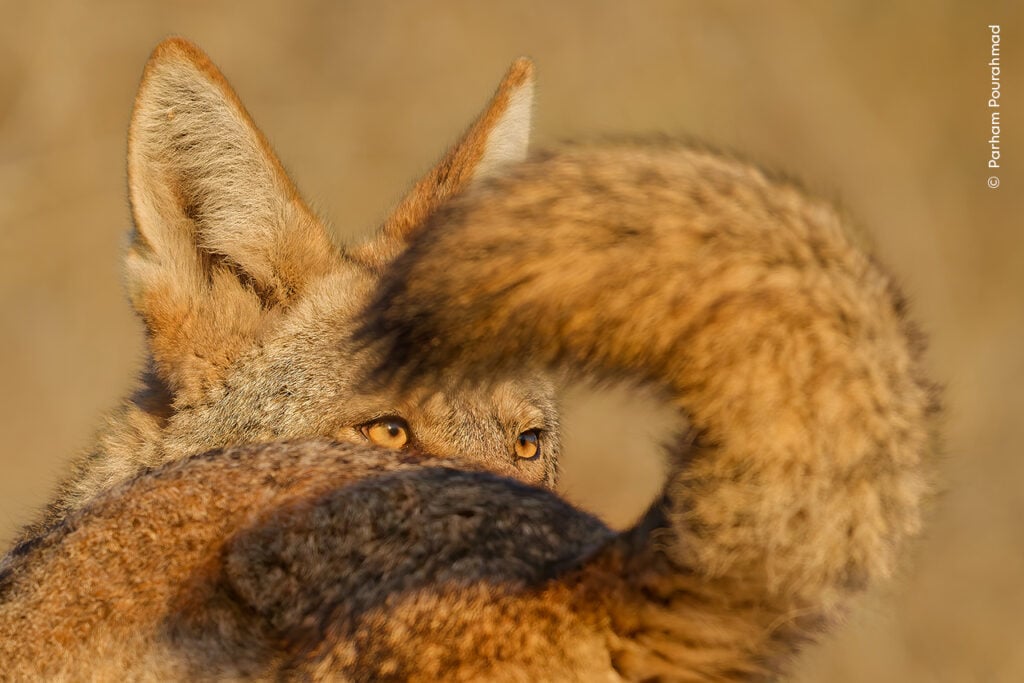
The piercing yellow eyes of a coyote are framed by a fluffy, curling tail that arches over the top.
Don’t be fooled by these wily coyotes, as there are actually two in this image taken in Bernal Heights Park, San Francisco.
While following this pair of siblings across the rocky hillside, Parham managed to get the perfect shot in which the brother’s amber eyes were framed by the sister’s black-tipped tail.
Slime Family Portrait by Kutub Uddin
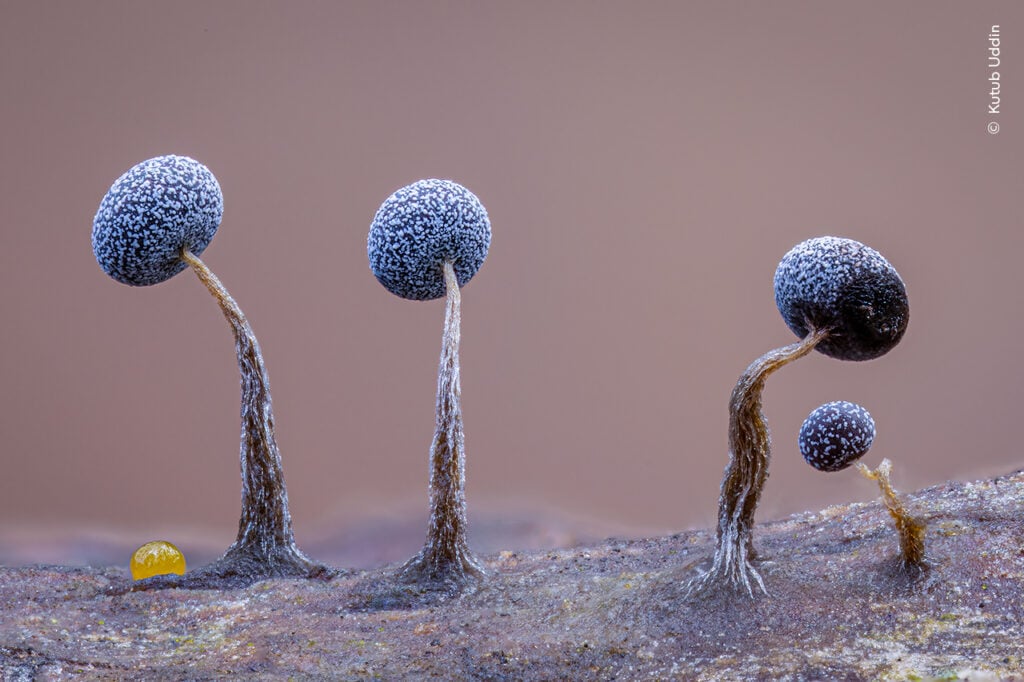
Looking a little like blueberries on a stalk, these perfectly formed slime moulds caught the attention of Kutub as he was exploring Slindon Wood, which is in West Sussex in England.
Measuring just a couple of millimetres across, the moulds are actually a community of single-celled amoeba-like organisms that come together to find food and reproduce.
A slime mould is a community of mobile single-celled, amoeba-like organisms that live independently until they come together and work as one to find food and reproduce
Special Delivery by Bidyut Kalita
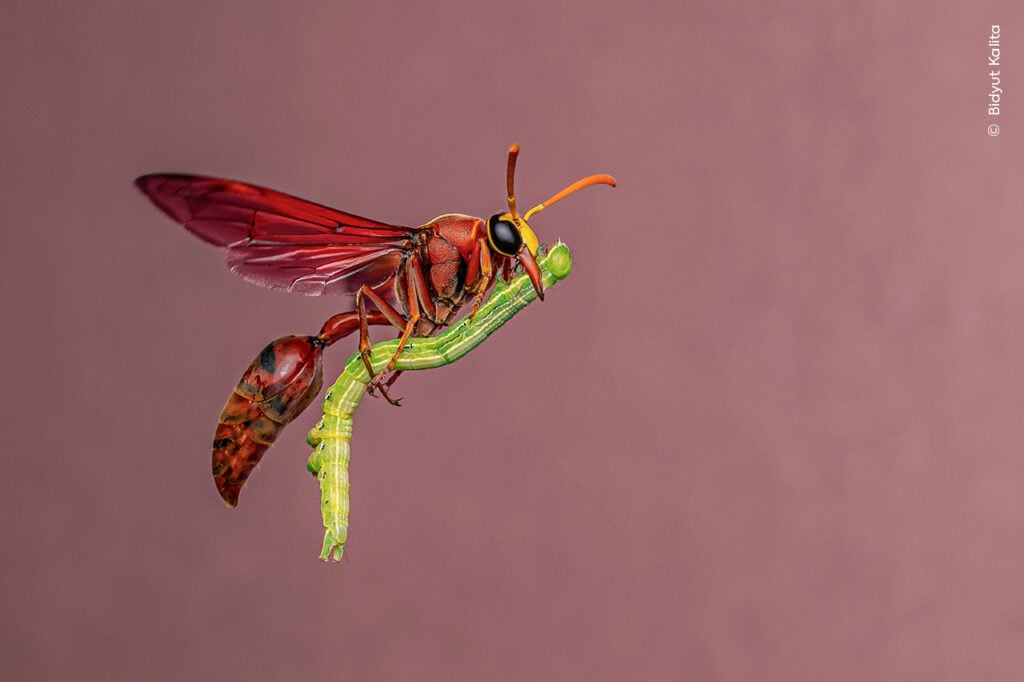
A reddish-pink coloured wasp flying in front of a pink wall carrying between its legs a bright green caterpillar.
Potter wasps are known to build a little chamber before filling it with paralysed prey for their developing larvae.
So when Bidyut spotted one of the wasps flying into home in Goalpara, India, he set about preparing the scene. Wedging a door open to give the wasp full access, he managed to photograph the exact moment it returned with a bright green caterpillar between its mouth and legs.
Pause, reflect and reconnect with the natural world through images that celebrate nature’s awe-inspiring beauty and urge us to protect it.
Details
When: 7 October 2025 to 12 July 2026
Where: East Pavilion Gallery, South Kensington, London
Price: Adult off-peak tickets from £15.50, standard tickets from £18




